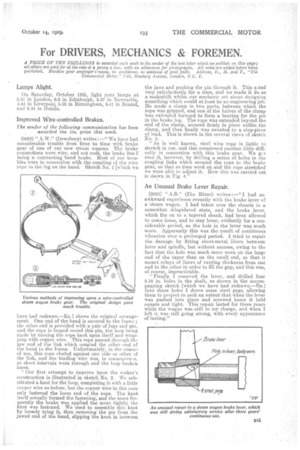For DRIVERS, MECHANICS & FOREMEN.
Page 23

If you've noticed an error in this article please click here to report it so we can fix it.
A PRIZE OF TEN SBILLING8 is (warded each week to the sender of the best letter which we publish on this page ; all others are paid for at the rate of a palm a haw, with an allowance for photographs. All notes are edited before being published. Mention your employer's ,name. in colyidence, as evidence of good faith. Address, D„ M. and F„ "The Commercial Motor," 7-15, Rosebery Avenue, London, R.C. 1.
Lamps Alight.
On Saturday, October 18th, light your lamps at 5.31 in London, 6.6 in Edinburgh, 5.37 in Newcastle, 5.41 in Liverpool, 5.38 in Birmingham, 5.41 in Bristol, and 6.24 in Dublin.
Improved Wire-controlled Brakes.
The sender of the following communication has been awarded the 10s. prize this week.
(2022) " A.W." (Dewsbury) writes :—" We have had considerable trouble from time to time with brake gear of one of our new steam wagons. The brake connections were wire, and not rods, the brake itse.f being a contracting band brake. Most of our troubles were in connection with the coupling of the wire rope to the lug on the band. Sketch No. 1 [which we have had redrawn.—En.] shows the original arrangement. One end of the band is secured to the frame ; the other end is provided with a pair of lugs and pin, and the rope is looped round this pin, the loop being made by turning the rope back upon itself and wrapping with copper wire. This rope passed through the jaw end of the link which coupled the other end of the band to the frame. Unfortunately, in the courv of use, this rope chafed against one side or other of the link, and the binding wire was, in consequeme, at, short intervals worn through and the loop broken loose.
Our first attempt to improve upon the nnaker's construction is illustrated in sketch No. 2. We substituted a knot for the loop, completing it with a little copper wire as before, but the copper wire in this ease only fastened the loose end of the rope. The knot itself actually formed the fastening, and the more frequently the brake was applied the more tightly the knot was fastened. We used to assemble this knot by loosely tying it, then removing the pin from the jawed end of the band, slipping the knot in between the jaws and pushing the pin through it. This acted very satisfactorily for a time, and we made it do as a makeshift whilst our mechanic sot about designing' something which would at least be an engineering job. He made a clamp in two parts, between which the rope was gripped, and one of the halves of the clamp was extended forward to form a bearing for the pin in the brake lug. The rope was extended beyond the end of the clamp, secured firmly in place within the clamp, and then finally was sweated to a stop-piece of lead. This is shown in the several views of sketch No. 3. . "As is well known, steel wire rope is liable to stretch in use, and this occasioned another little difficulty in connection with this brake gear. We get over it, however, by drilling a series of holes in the coupling links which secured the rope to the brake gear, so that as time went on and the rope stretched we were -able to adjust it.. How this was carried out, is shown in Fig. 4."
An Unusual Brake Lever Repair.
.N023] " A.l3." (The Rhine) writes :—" I had an awkward experience recently with the brake lever of a steam wagon. I had taken over the chassis in a somewhat dilapidated state, and the brake lever, which fits on te a tapered shank, had been allowed to coMe loose, and to stay loose, evidently for a considerable .period, as the hole in the lever was much worn. Apparently this was the result of continuous vibration over a prolonged period. I tried to repair the damage by fitting sheet-metal liners between lever and spindle, but without success, owing to the fact that the hole was much more worn on the large end of the taper than on the small end, so that it meant relays of liners of varying thickness from one end to the other in order to fill the gap, and this was, of course, impracticable. "Finally I removed the lever, and drilled four 5-16 in. holes in the shaft, as shown in the accompanying sketch [which we have had redrawn.—En.] Into these holes I drove some steel pegs, allowing them to projectto such an extent that when the lever was pushed into place and screwed home it held square and tight. This repair lasted for three years while the wagon was still in my charge, and when I left it was still going strong, with every appearance of lasting."
























